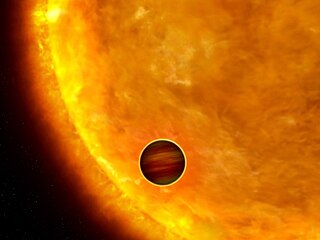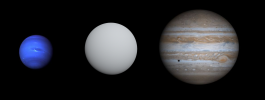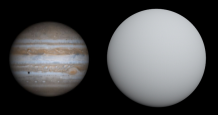
CoRoT was a space telescope mission which operated from 2006 to 2013. The mission's two objectives were to search for extrasolar planets with short orbital periods, particularly those of large terrestrial size, and to perform asteroseismology by measuring solar-like oscillations in stars. The mission was led by the French Space Agency (CNES) in conjunction with the European Space Agency (ESA) and other international partners.

HD 80606 and HD 80607 are two stars comprising a binary star system. They are approximately 217 light-years away in the constellation of Ursa Major. Both stars orbit each other at an average distance of 1,200 astronomical units. The binary system is listed as Struve 1341 in the Struve Catalogue of Double Stars; however, this designation is not in wide use and the system is usually referred to by the HD designations of its constituent stars. An extrasolar planet has been confirmed to orbit HD 80606 in a highly elliptical orbit.
HD 147506, also known as HAT-P-2 and formally named Hunor, is a magnitude 8.7 F8 dwarf star that is somewhat larger and hotter than the Sun. The star is approximately 419 light-years from Earth and is positioned near the keystone of Hercules. It is estimated to be 2 to 3 billion years old, towards the end of its main sequence life. There is one known transiting exoplanet, and a second planet not observed to transit.

WASP-8b is an exoplanet orbiting the star WASP-8A in the constellation of Sculptor. The star is similar to the Sun and forms a binary star with a red dwarf star (WASP-8B) of half the Sun's mass that orbits WASP-8A 4.5 arcseconds away. The system is 294 light-years away and is therefore located closer to Earth than many other star systems that are known to feature planets similar to WASP-8b. The planet and its parent star were discovered in the SuperWASP batch -6b to -15b. On 1 April 2008, Dr. Don Pollacco of Queen's University Belfast announced them at the RAS National Astronomy Meeting.

WASP-8 is a binary star system 294 light-years away. The star system is much younger than the Sun at 300 million to 1.2 billion years age, and is heavily enriched in heavy elements, having nearly twice the concentration of iron compared to the Sun.
HD 185269 b is a hot Jupiter extrasolar planet approximately 170 light years away in the constellation of Cygnus. The minimum mass is slightly less than Jupiter and the orbital period is about one week. Most hot Jupiters are thought to have undergone tidal circularization, making the eccentricity of HD 185269 b (e=0.3) unusual. Despite having a large transit probability, none have yet been detected by various photometric monitoring campaigns.
HAT-P-4 is a wide binary star consisting of a pair of G-type main-sequence stars in the constellation of Boötes. It is also designated BD+36°2593.
XO-2 is a binary star system about 490 light-years away in the constellation Lynx. It consists of two components, XO-2N and XO-2S, both of which host planetary systems.

CoRoT-1 is a yellow dwarf main sequence star similar to the Sun. The star is located approximately 2,630 light-years away in the constellation of Monoceros. The apparent magnitude of this star is 13.6, which means it is not visible to the naked eye; however, it can be seen through a medium-sized amateur telescope on a clear, dark night. The first exoplanet discovered in the course of the CoRoT mission orbits this star; it is considered to be a "hot Jupiter", and is approximately as massive as the planet Jupiter itself.
CoRoT-2 is a yellow dwarf main sequence star a little cooler than the Sun. This star is located approximately 700 light-years away in the constellation of Aquila. The apparent magnitude of this star is 12, which means it is not visible to the naked eye but can be seen with a medium-sized amateur telescope on a clear dark night.
CoRoT-6 is a magnitude 13.9 star located in the Ophiuchus constellation.
HAT-P-17 is a K-type main-sequence star about 92.6 parsecs (302 ly) away. It has a mass of about 0.857 ± 0.039 M☉. It is the host of two planets, HAT-P-17b and HAT-P-17c, both discovered in 2010. A search for a binary companion star using adaptive optics at the MMT Observatory was negative. A candidate companion was detected by a spectroscopic search of high-resolution K band infrared spectra taken at the Keck observatory.

CoRoT-8b is a transiting exoplanet orbiting the K-type main sequence star CoRoT-8 1,050 light years away in the equatorial constellation Aquila. The planet was discovered in April 2010 by the CoRoT telescope.
HD 146389, is a star with a yellow-white hue in the northern constellation of Hercules. The star was given the formal name Irena by the International Astronomical Union in January 2020. It is invisible to the naked eye with an apparent visual magnitude of 9.4 The star is located at a distance of approximately 446 light years from the Sun based on parallax, but is drifting closer with a radial velocity of −9 km/s. The star is known to host one exoplanet, designated WASP-38b or formally named 'Iztok'.
HD 1690 is a giant star with an orbiting exoplanet companion in the constellation of Cetus. It has an apparent visual magnitude of 9.19, which is too faint to be visible to the naked eye. The distance to this system is approximately 2,570 light years, and it is drifting further away with a radial velocity of +18.2 km/s. HD 1690 has no known companion star, making it a single star system.
WASP-54, also known as BD+00 3088, is a binary star system about 825 light-years away. The primary, WASP-54A, is a F-type main-sequence star, accompanied by the red dwarf WASP-54B on a wide orbit. WASP-54 is depleted in heavy elements, having 55% of the solar abundance of iron. The age of WASP-54 is slightly older than the Sun's at 6.9+1.0
−1.9 billion years.
CoRoT-16 is a solitary star located in the equatorial constellation Scutum. With an apparent magnitude of 16, it requires a powerful telescope to be seen, and is located 2,400 light years away based on parallax.











